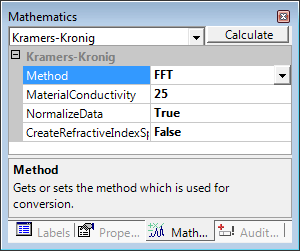Kramers Kronig Transformation details
The Kramers Kronig Transformation is used for obtaining absorbance and refractive index information from reflectance data. Measuring a reflectance spectrum from an optically dense material will yield a complex spectrum with two components - the absorbance spectrum and the refractive index spectrum. The Kramers Kronig transformation will extract these components from the complex reflectance spectrum.
The Kramers Kronig transformation assumes reflectance angles near zero. The output of the transformation strongly depends on the measurement quality, artefacts in the low wavelength region need to be eliminated properly or the transformation will yield inadequate results.
Because of the material constants - which are required for the calculation but are unknown to the software - the spectrum has to be extrapolated to zero wavelengths. Consequently it is necessary, depending on the available equipment and IR-Spectrometer, to measure as close as possible to the lowest available wavelength. This will decrease the influence of the extrapolation on the Kramers Kronig transformation.
Kramers Kronig Options
The dialog for the Kramers Kronig transformation looks like this:

The following options are available for the transformation:
Method
Specifies the calculation method for the Kramers Kronig transformation:
-
FFT
Uses Fast-Fourier-Transformation for the calculation -
MacLaurin
Uses MacLaurins formula for the calculation
Material Conductivity
Specifies the material constant. The default setting is 25 which represents a conductive material. The material constant has influence on the algorithm used for extrapolation and may be used to adapt the calculation to the experimental conditions.
Normalize Data
Controls the automatic normalization of the resulting spectra:
-
Yes
The resulting spectra will be automatically normalized between 0 and 2. -
No
The resulting spectra will not be normalized.
Create Refractive Index Spectrum
Controls the type of result spectrum for the transformation:
-
True
A refractive index spectrum will be created and displayed as result. -
False
An absorbance spectrum will be created and displayed as result.
Kramers Kronig Algorithm
The refractive index part (real part) is calculated by the following equation:
The extinction part (imaginary part) is calculated by the following equation:
The phase shift angle of the sample for a given wavenumber is calculated as:
Legend:
- n: wave number
- R: Reflectance spectrum
- q: phase shift angle